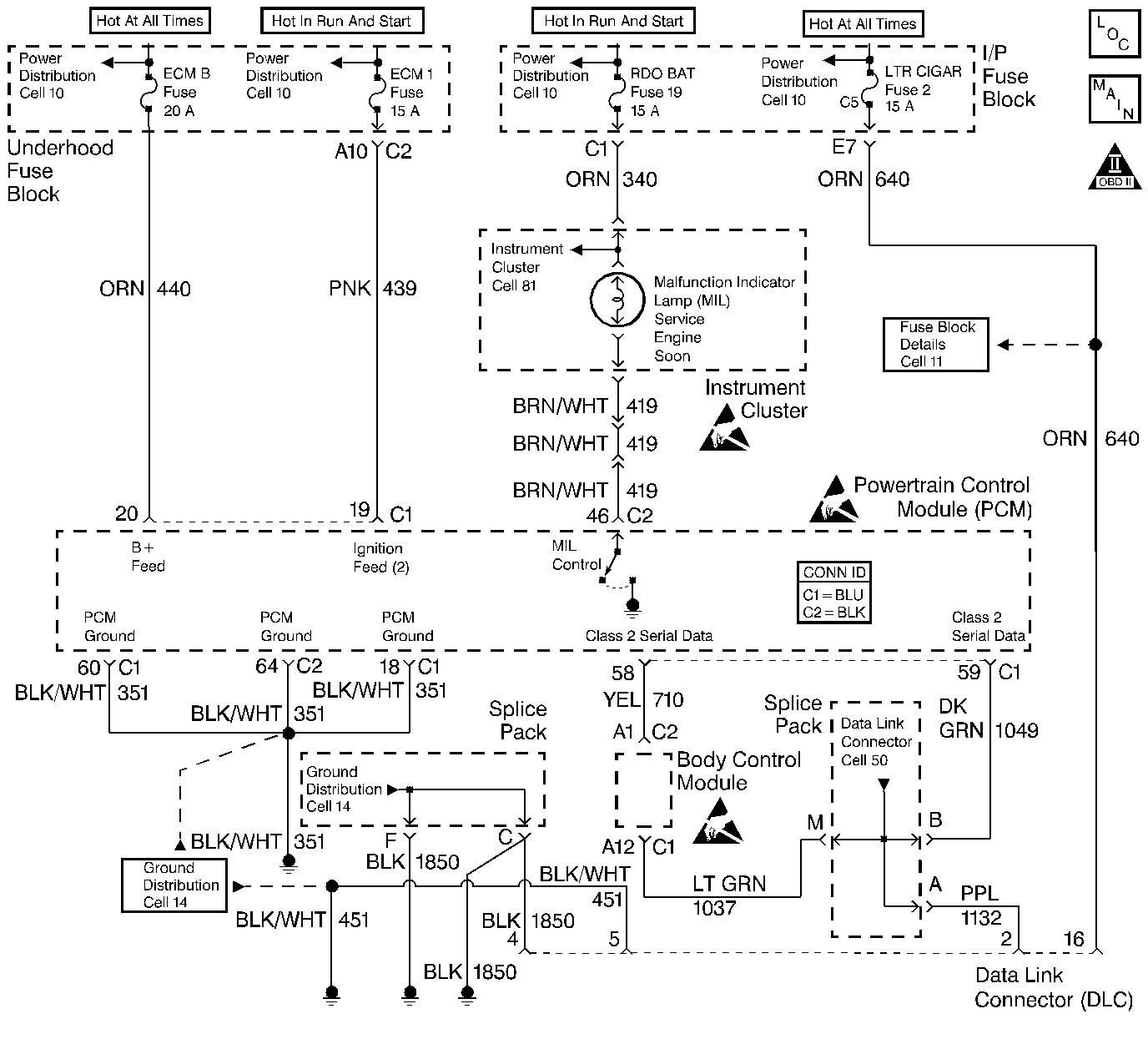
Circuit Description
When the ignition is turned ON, the MIL will momentarily flash ON then OFF then remain ON until the engine is running, if no diagnostic trouble codes (DTCs) are stored. Battery voltage is supplied through the ignition switch directly to the malfunction indicator lamp (MIL) telltale. The powertrain control module (PCM) controls the MIL by providing a ground path through the MIL control circuit in order to turn ON the MIL.
Diagnostic Aids
An open ignition fuse causes the MIL to be inoperative.
Check any circuitry that is suspected of causing an intermittent problem for the following conditions:
| • | Improper mating |
| • | Broken locks |
| • | Improperly formed or damaged terminals |
| • | Physical damage to the wiring harness |
Test Description
The numbers below refer to the step numbers on the diagnostic table.
-
The Powertrain OBD System Check prompts you to complete some of the basic checks and to store the Freeze Frame and Failure Records data on the scan tool, if applicable. This creates an electronic copy of the data captured when the malfunction occurred. The scan tool stores this data for later reference.
-
If no malfunctions are present at this point and no DTCs were set, refer to Diagnostic Aids for additional checks and information.
-
If the engine fails to start and the MIL is inoperative, then the malfunction can be isolated to one of the following items:
-
Program the replacement PCM and perform the Crankshaft Position System Variation Learn Procedure. Refer to the latest Techline information for PCM programming.
| • | Open ECM B fuse |
| • | Open ECM 1 fuse |
| • | Poor ground at the engine block |
| • | Malfunctioning PCM |
Step | Action | Values | Yes | No | ||||||
|---|---|---|---|---|---|---|---|---|---|---|
Did you perform the Powertrain On-Board Diagnostic (OBD) System Check? | -- | Go to | ||||||||
Turn ON the ignition, with the engine OFF. Is the MIL ON? | -- | Go to Diagnostic Aids | ||||||||
Attempt to start the engine. Does the engine start? | -- | |||||||||
4 | Check the gauges fuse in the instrument panel fuse block for an open. Is the fuse open? | -- | ||||||||
5 |
Is the test lamp ON? | -- | ||||||||
6 |
Is a fuse open? | -- | ||||||||
7 |
Is the test lamp ON? | -- | ||||||||
8 |
Is the test lamp ON? | -- | ||||||||
9 |
Is the action complete? | -- | -- | |||||||
Important: The replacement PCM must be programmed. Is the action complete? | -- | -- | ||||||||
11 | Repair the short to voltage in the MIL control circuit. Refer to Wiring Repairs in Wiring Systems. Is the action complete? | -- | -- | |||||||
12 |
Was a repair necessary? | -- | ||||||||
13 |
Is the test lamp ON? | -- | ||||||||
14 | Repair the short to ground between the gauges fuse and the instrument cluster. Refer to Wiring Repairs in Wiring Systems. Is the action complete? | -- | -- | |||||||
15 |
Was a repair necessary? | -- | ||||||||
16 | Repair the open in the battery positive voltage circuit. Refer to Wiring Repairs in Wiring Systems. Is the action complete? | -- | -- | |||||||
17 | Replace the IPC. Refer to Instrument Cluster Replacement in Instrument Panel, Gauges and Console. Is the action complete? | -- | -- | |||||||
18 | Repair the open in the B+ circuit from the ECM B fuse and the PCM. Is the action complete? | -- | ||||||||
19 |
Does the scan tool display any DTCs that you have not diagnosed? | -- | Go to applicable DTC table | System OK |
